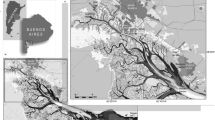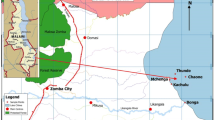Abstract
Sediment quality data provide essential information for evaluating ambient environmental quality conditions. An evaluation is presented of heavy metal pollution, on the basis of statistical analysis of metal concentrations from the sediments of the Gulf of Gemlik, southeastern Marmara Sea, Turkey, which has been subject to high levels of pollution. The ranges for heavy metal concentrations (Co, Cr, Cu, Fe, Mn, Ni, Pb and Zn) at the <63 μm grain size were higher when compared with those obtained from >63 μm fractions. Not only large industrialized seaports but also resort areas throughout the Gulf are flagged as hotspots for elevated concentrations, generally higher compared to those from the other Turkish marine environment. The highest concentrations of Cr, Pb and Ni were measured in the outer part of the Gulf, while the highest concentrations of Cu were documented offshore the main rivers. While the concentrations of Cr, Fe, Mn and Ni in some stations approach the severe effect level given in various sediment quality guidelines, the concentrations of the most human-related metals (Cd and Zn) in the mussels collected from the Port Mudanya were higher than the acceptable values for human consumption set by various healthy organizations.
Similar content being viewed by others
References
Alkan, U., Çalışkan, S., Birden, B., & Cindoruk, S. (2000). Effluent discharges and size of fecal pollution along Mudanya coasts, Symposium Book of Marmara Sea 2000, 11–12 Nov. 2000. In B. Öztürk, M. Kadıoğlu, & H. Öztürk (Eds.), Türk Deniz Araştırmaları Vakfı, Publ. No: 5 (pp. 536–542), in Turkish.
Baptista Neto, J. A., Smith, B. J., & Mcallister, J. J. (1999). Heavy metal concentrations in surface sediments in a nearshore environment, Jurujuba Sound, SE Brazil. Environmental Pollution, 108, 1–9.
Balkıs, N., & Çağatay, M. N. (2001). Factors controlling metal distributions in the surface sediments of the Erdek Bay, Sea of Marmara, Turkey. Environment International, 27, 1–13.
Bodur, M. N., & Ergin, M. (1994). Geochemical characteristics of the recent sediments from the Sea of Marmara. Chemical Geology, 115, 73–101.
Casado-Martinez, Buceta, J. L., Belzunce, M. J., & DelVals, T. A. (2006). Using sediment quality guidelines for dredged material management in commercial ports from Spain. Environment International, 32, 388–396.
CCREM (Canadian Council of Resource and Environment Ministers). (1987). Canadian water quality guidelines. Prepared by the Task Force on Water Quality Guidelines.
D.I.E. (2003). Statistical Report of Turkey, Publication of Turkish State Institute of Statistics (in Turkish)
EPA (1991). GEO-EAS (Geostatistical Environment Assessment Software) Version 1.2.1 User’s Guide, Environmental Monitoring Systems Laboratory, US Environmental Protection Agency (EPA). EPA/600/8-91/008, Las Vegas, USA
Ergin, M., & Bodur, M. N. (1999). Silt/clay fractionation in surficial Marmara sediments: implication for water movement and sediment transport paths in a semi-enclosed and two-layered flow system (northeastern Mediterranean Sea). Geo-Marine Letters, 18, 225–233.
Ergin, M., Saydam, C., Baştürk, Ö., Erdem, E., & Yörük, R. (1991). Heavy metals concentrations in surface sediments from two coastal inlets (Golden Horn Estuary and Izmit Bay) of the northeastern Sea of Marmara. Chemical Geology, 91, 269–285.
Fabris, G. J., Monahan, C. A., & Batley, G. E. (1999). Heavy metals in waters and sediments of Port Phillip Bay, Australia. Marine and Freshwater Research, 50, 503–533.
FAO (1989). Food safety regulations applied to fish by major importing countries. Fisheries Circular no. 825, FAO, Rome.
Förstner, U., & Salamons, W. (1980). Trace metal analysis on polluted sediments, Part:1: assessment of sources and intensities. Environmental Technology Letters, 1, 494–505.
Gonçalves, E. P. R., & Boaventura, R. (1991). Sediments as indicators of the river Ave Contamination by heavy metals. Raposa, Integrated Approaches to Water Pollution Problems (pp. 209–218). London: Elsevier.
Gonçalves, E. P. R., Soares, H. M. V. M., Boaventura, R. A. R., Machado, A. A. S. C., & Silva, J. C. G. E. (1994). Seasonal variations of heavy metals in sediments and aquatic mosses from the Cavado river basin (Portugal). Science of the Total Environment, 114, 7–24.
Groot, A. J., Zschuppe, K. H., & Salomons, W. (1982). Standardization of methods of analysis for heavy metals in sediments. Hydrobiologia, 92, 689–695.
Güven, K. C., Saygı, N., & Öztürk, B. (1993). Survey of metal contents of Bosphorus algae, Zostera marina and sediments. Botanica Marina, 36, 175–178.
Kilgour, B. W. (1991). Cadmium uptake from cadmium-spiked sediments by four freashwater invertebrates. Bulletin Environmental Contamination and Toxicology, 47, 70–75.
Krauskopf, K. B. (1979). Introduction to geochemistry.(p. 6172nd ed.). Tokyo: McGraw-Hill Kogakusha, Ltd.
Lee, B.-S., Bullister, J. L., Murray, J. W., & Sonnerup, R. E. (2002). Anthropogenic chlorofluorocarbons in the Black Sea and Sea of Marmara. Deep Sea Research I, 49, 895–913.
Lucas, M. F., Caldeira, M. F., Hall, A., Duarte, A. C., & Lima, C. (1986). Distribution of mercury in sediments and fishes of the Kagoon of Averio, Portugal. Water Science and Technology, 16, 247–252.
Merian, E. (1991). Metals and their compounds in the environments. Occurrence Analysis and Biological Relevance ISBN 0-89573-562-8, VCH New York.
Molvær, J., Knutzen, J., Magnusson, J., Rygg, B., Skei, J., & Sørensen, J. (1997). Klassifisering av miljøkvalitet ifjorder og kystfarvann. Veiledning. Classification of environmental quality in fjords and coastal waters. A guide. State Pollution Control Authority. TA no. TA-1467/1997. 36 pp.
Mora, S., & Sheikholeslami, M. R. (2002). Final report: Interpretation of Caspian Sea sediment data. ASTP: Contaminant Screening Programme, 27 p.
Muniz, P., Danular, E., Yannicelli, B., Alonso, J. G., Medina, G., & Bicego, C. (2004). Assessment of contamination by heavy metals and petroleum hydrocarbons in sediments of Montevideo Harbour (Uruguay). Environment International, 29, 1019–1028.
Romankevich, E. A. (1984). Geochemistry of organic matter in the ocean. Berlin, Heidelberg, New York: Springer and Verlag.
Sarı, E., & Çağatay, M. N. (2001). Distributions of heavy metals in the surface sediments of the Gulf of Saros, NE Aegean Sea. Environment International, 26, 169–173.
Shiganova, T., Tarkan, A., Dede, A., & Cebeci, M. (1995). Distribution of the ichthyo-Jellyplankton Mnemiopsis leidyi (Agassiz, 1965) in the Marmara Sea. Turkish Journal of Marine Sciences, 1, 3–12.
Soares, H. M. V. M., Boaventura, R. A. R., Machado, A. A. S. C., & Esteves da Silva, J. C. G. (1999). Sediments as monitors of heavy metal contamination in the Ave river basin (Portugal): multivariate analysis of data. Environmental Pollution, 105, 311–323.
Topçuoğlu, S. (2002). Monitoring of radionuclides and heavy metals in Turkish Black Sea Coast, Bosphorus and Marmara Sea using mussels (Mytilus galloprovincialis) as a bioindicator. CIESM Workshop Series, 15, 109–112.
Topçuoğlu, S., Kırbaşoğlu, Ç., & Güngör, N. (2001). Heavy metals in organisms and sediments from Turkish coast of the Black Sea. Environment International, 27, 521–526.
Topçuoğlu, S., Kırbaşoğlu, Ç., & Yılmaz, Y. Z. (2004). Heavy metal levels in biota and sediments in the northern coast of the Marmara Sea. Environmental Monitoring and Assessment, 96, 183–189.
USEPA (United States Environmental Protection Agency), (1999). Update of Ambient Water Quality Criteria for Ammonia.
Uz, B., Esenli, F., Manav, H., & Aydos, Z. (1995). Authigeneous mineral composition of pyroclastic rocks between Karamürsel and Yalova–NW Anatolia. Geosound, 27, 135–147 (in Turkish).
Ünlü, S., & Alpar, B. (2006). Sources and geochemical constraints of hydrocarbons in surface sediments of Gemlik Bay (Marmara Sea, Turkey). Chemosphere, 64, 764–777.
Ünlü, S., Alpar, B., Aydın, S., Akbulak, C., Balkıs, N., Barut, I., Meric, E., Aksu, A., & Kirbasoglu, C. (2006). Anthropogenic pollution in sediments from the Gulf of Gemlik (Marmara Sea, Turkey); cause–result relationship. Fresenius Environmental Bulletin, 15(12a), 1521–1560.
Yüksek, A., Okuş, E., & Yılmaz, N. (2004). The effect of dissolved oxygen on the distribution of demersal fish and benthic organisms in the Sea of Marmara (30–300 m).National ecology and environment congress pp. 219–228. Abant: Bolu.
Author information
Authors and Affiliations
Corresponding author
Rights and permissions
About this article
Cite this article
Ünlü, S., Topçuoğlu, S., Alpar, B. et al. Heavy metal pollution in surface sediment and mussel samples in the Gulf of Gemlik. Environ Monit Assess 144, 169–178 (2008). https://doi.org/10.1007/s10661-007-9986-6
Received:
Accepted:
Published:
Issue Date:
DOI: https://doi.org/10.1007/s10661-007-9986-6




